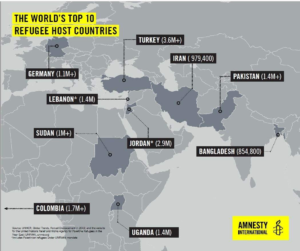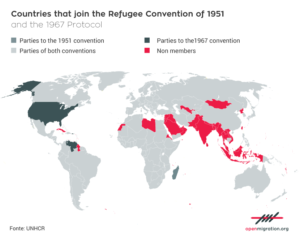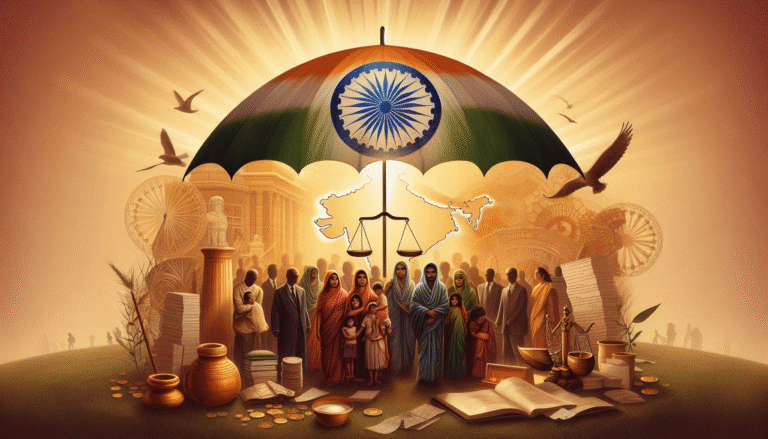
Right to Asylum: Indian Subcontinent

Introduction
Since time immemorial, humans have travelled a long distance for better resources. In the present era, with the development of technology, human mobility has become more fluid.
Many of us have travelled a long distance for better opportunities, to visit family, or simply for sightseeing. However, some people have to flee from their homes without knowing if they will ever come back.
There are many reasons for people to leave their homes with such uncertain futures. These include violence, persecution, war, hunger, extreme poverty, discrimination, natural disaster, climate change, etc. Unfortunately, these people are not always welcome. Many face legal issues and have a hard time finding a livelihood. The situation is barely better than in their home nations.
Presently, there are around 26 million people who have faced such issues. Despite it being their right to seek protection and asylum under the 1951 Refugee Convention, they face multiple issues while dealing with the administration and other authorities of various host nations.
This article delves into the extent of the right to seek asylum and the scope of the same in the Indian subcontinent.
Defining asylum seekers
Before understanding the rights that asylum seekers have, we need to understand the term asylum. Today, many people confuse asylum seekers with refugees and migrants and even use these terms synonymously. However, these terms are used to determine different sections of people.
Those people who have to flee from their countries as they are at serious risk of human violations and persecution there are known as refugees. A similar criterion exists for asylum seekers as well, however, these people are those who have not been legally recognized by the government of host countries as refugees.
The term ‘migrants’ is not defined in international law, hence no universally accepted definition exists. However, International Organisation for Migration (a.k.a. IOM, UN migration) defines migrants as people who move away from their usual residence within their country or across international borders temporarily or permanently for a variety of reasons. Migrants are considered to be an umbrella term that includes migrant labourers, smuggled migrants, international students, etc.
Right to seek asylum
The phenomenon of people seeking refuge or asylum is an ancient one. However, it was only after the second world war, the world felt the need for a legal instrument to regulate this phenomenon. Therefore, article 14 of the Universal Declaration of Human Rights, 1950 dealt with the right to asylum.
With the preceding article (article 13) dealing with the right to leave one’s country and the succeeding article (article 15) the right to nationality, it becomes obvious that the intention of the drafters was centred around the Jewish refugees of the Holocaust.
In another year, 1951, a more articulated document was formed known as the Convention Relating to Status of Refugees, 1951 or simply the Refugees Convention 1951. This convention gives more clarity to who can invoke the right to asylum. Asylum cannot simply be granted to anyone who crosses international boundaries due to the risk of persecution. It must also be considered if the person has committed any non-political crime outside the host country or if he acted against the principles of the UN or if he violated rights and obligations drawn up in certain international treaties.
Many international agencies work to protect these people such as UNHRC, Amnesty Internation, OAS Migration, etc. Their role is extremely significant in the present scenario as nations have started keeping asylum seekers out by barbed wires, walls, and armies. These organizations coordinate between authorities and asylum seekers and pressure governments to honour their equitable responsibility in hosting and supporting the world’s refugees, migrants, and asylum seekers.
Indian subcontinent
Across the globe, 85% of refugees are hosted by developing nations, and a good proportion of the same is hosted by the Indian subcontinent. Two of the world’s top ten host countries, Pakistan and Bangladesh are situated in the Indian subcontinent, still, none of the countries within the subcontinent is part of the Refugee Convention, of 1951.

India
India is a popular destination for asylum seekers, especially within the subcontinent. This is because despite being a non-member of the refugee convention, India has adopted the principles of UDHR in its Constitutional law. Therefore, it is not completely hostile to refugees.
Also, while the Indian legal system does not differentiate between foreigners who come voluntarily and those who come at the due risk of persecution, the judiciary has still created room to encompass the rights of these asylum seekers.
In cases like Maiwand’s Trust of Afghan Human Freedom vs. State of Punjab, ND Pancholi vs. State of Punjab & Others, Malavika Karlekar vs. Union of India, Luis De Raedt vs. Union of India and State of Arunachal Pradesh vs. Khudiram Chakma, the judiciary recognized the plight of refugees and asylum seekers and upheld their right to life and liberty and nonrefoulement.
Pakistan
After Russian aggression against Afghanistan, Pakistan saw a huge influx of Afghani refugees and asylum seekers. Despite having no formal law for refugees and being a non-member of the refugee convention, Pakistan has shown generous hospitality to almost 2.4 million Afghan refugees in its territory. Pakistan provides impermanent shelters to these refugees (those under UNHCR mandate) and adequate protection as it is bound under the 2003 tripartite treaty among Pakistan, Afghanistan, and United Nations High Commission for Refugees.
Pakistan follows principles enacted under the Convention Against Torture and its national legislation Foreigner’s Act of 1946 to deal with the issue of asylum seekers and refugees. Hence, administrative measures taken are commendable however due to the lack of a legal framework, there persist issues such as livelihood and permanent shelters.
Bangladesh
Since the 1970s, Bangladesh has been the most popular destination for Rohingya Muslims from Myanmar. However, the influx of these asylum seekers significantly increased in 2017. Bangladesh also has no domestic law on the subject of refugees and is also a non-member of the refugee convention. Yet, being a signatory to human rights treaties such as the UN Convention on the Rights of the Child, Bangladesh provides rights to certain groups of refugees and asylum seekers.
Like many other developing countries, unstable political situations and economic priorities have made Bangladesh reluctant to form any formal legislation on the matter of refugees and asylum seekers. Also, Rohingya Muslims have been considered to be the primary culprits to the increase in the drug trade and crime rates making Bangladesh view them as a threat to national security and become more hostile to these asylum seekers. Therefore, a deal over the matter of repatriation has been signed between Bangladesh and Myanmar. Yet, the asylum seers keep on coming to Bangladesh making it obvious that policies such as forced repatriation cannot solve this issue.
Regional Organizations
The Indian subcontinent hosts a significant number of refugees and asylum seekers. While international organizations such as UNHRC and Amnesty International assist, there exists a structural difference between societies of this region and those in the West, which render these international organization barely helpful. Therefore, there is a requirement for a regional institution that would specialize in dealing with refugees and asylum seekers in the Indian Subcontinent.
The existing regional organizations such as ASEAN and SAARC have shown a policy of non-interference on the matter of refugees and asylum seekers. This approach is due to political sensitivity and regional discord in the Indian subcontinent. The host nations prefer drawing bilateral treaties to forming specialized legal instruments and organizations to overlook the matter of refugees and asylum seekers. Therefore, while the existing regional organizations do have a vague framework regarding the matter, there is rarely actual involvement of these organizations in the refugee crisis in the region.

Conclusion
The refugee crisis and plight of asylum seekers cannot be overlooked. It is not an issue that would solve itself over a period of time. This issue requires careful consideration by various governments across the globe. The developed nations must also bear an equitable responsibility over this matter.
Humanitarian action precedes any regional discord. Therefore, it is the need of the hour that the Indian subcontinent rises over its political issues and frame regional mechanisms and legal systems to deal with the issue of refugees and asylum seekers.







